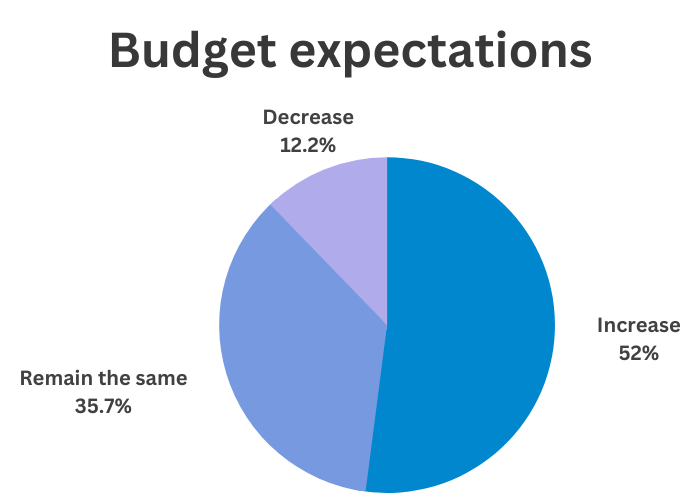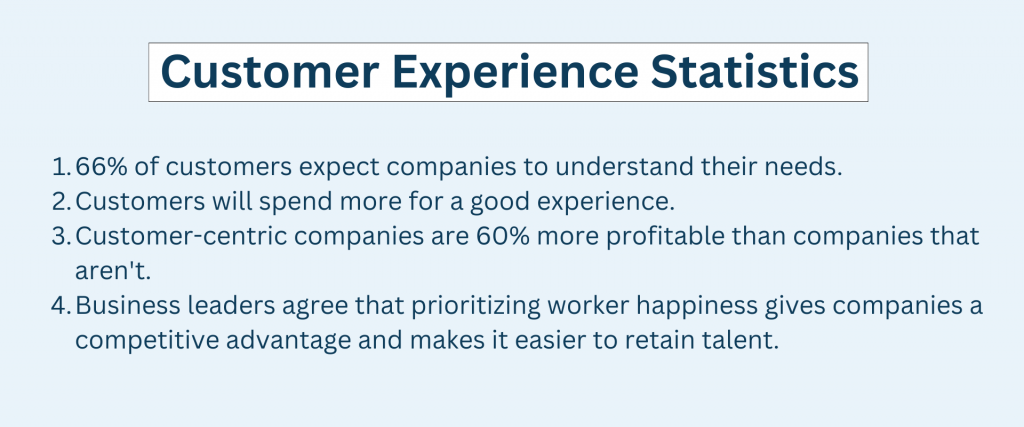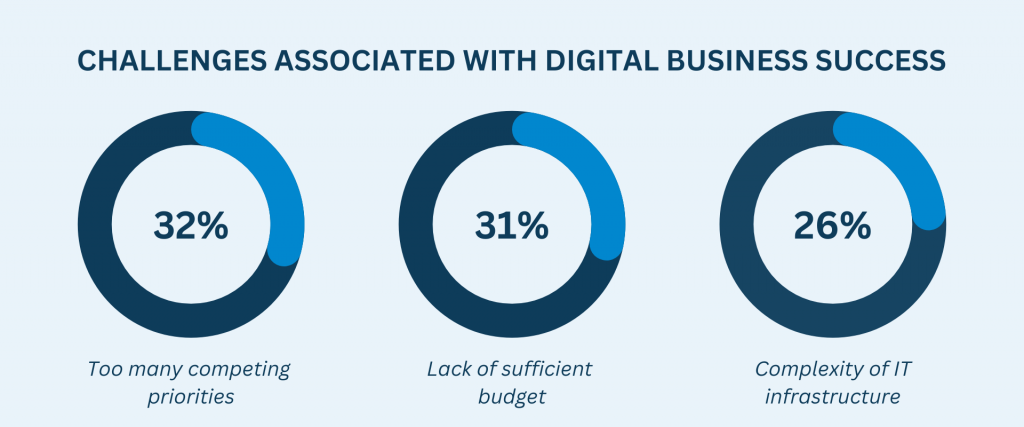Content
The world of business is constantly evolving. And digital transformation has become an integral part of it. From customer expectations to market disruptions, there are numerous factors that can prompt a company to embark on a digital transformation journey.
But don’t just take our word for it. Here are the findings from surveys carried out among top managers all over the globe.
According to the research conducted by Dell Technologies and the Institute for the Future, 73% of senior decision-makers across the world believe they need to be more digital to succeed in the future.
In a different study, we reveal that 91% of businesses are already adopting or going to adopt a digital-first business strategy to enable better worker productivity (using mobile apps for better data access and AI), manage business performance, and meet customer expectations.
Finally, even despite recession fears in a climate fraught with uncertainty—business, economic, geopolitical, and otherwise—companies will maintain the focus on tech innovations. Nearly half of the surveyed organizations are going to increase their IT budget in 2023, while only 12% will slow down their investments in technology.

As we can see, recent events (post-pandemic market landscape and the economic crisis caused by the war in the heart of Europe) have forced companies to accelerate digital transformation to deliver better customer and employee experiences.
But does your company need to start a digital transformation? In this article, we explore the signs that suggest it’s time for your organization to embrace digital transformation.
How to Know Your Organization Is Ready to Embrace Digital Transformation
Digital improvement is on everyone’s agenda now. However, the most challenging aspect of implementing any transformation is not making the decision whether to embark on it or not. Instead, it’s about defining whether the organization will gain distinctive returns on the investment.
Deloitte suggests that properly carried IT modernization can unlock $1.25 trillion in additional market capitalization across Fortune 500 companies. The odds of transformation success are also high for smaller organizations.
With that said, digital transformation initiatives have a high value to the enterprise. But how do you know that it’s time for you to invest in IT transformation? Look for the following signs:
- Difficulty in meeting customer expectations
- Manual and paper-based processes
- Inability to keep up with the competition
- Data silos and lack of data-driven decision-making
- Disconnected systems and technologies
- High IT costs
- Changing business models or strategies
Though, you should know that embracing digital transformation takes more than just bold investments and ambitions. The combination of actions is what can make or break it. And here is where the first challenges may happen. Interestingly, only 44% of companies undertaking IT modernization have reached a high level of maturity regarding this matter.
So, how to ensure your actions drive value and that the plan you have in your pocket actually works? Read on to learn what you need to do to make enterprise IT infrastructure improvement a success.
Steps for a Successful Digital Transformation Process
Digital transformation is a complex and ongoing process. Thus, the exact actions the enterprise should take to succeed will vary depending on the available resources, objectives, and the nature of modernization. Despite the complexity of the digital transformation journey, here are the core things you should focus on when planning a move to a more robust and modern IT environment.
Analyze Your Competition
The competition in the digital business landscape is getting more fierce. Before your enterprise embraces IT modernization, it is essential to study the market for a few reasons:
- Identify opportunities and gaps. By making the IT infrastructure assessment of your rivals, you will identify their successful digital transformation initiatives, as well as the gaps in their approach. This can help you identify areas where you can gain a competitive advantage by implementing digital solutions that your competitors have not yet adopted.
- Stay relevant. Digital transformation is an ongoing process, and the competitive landscape is constantly evolving. By analyzing your competition, you can stay up-to-date with the latest trends and innovations. This way, ensuring that your organization remains relevant and competitive in the long term.
- Benchmark your progress. Studying your competition can help you benchmark your own digital transformation progress. By comparing your organization’s digital capabilities to those of your competitors, you can determine whether you are ahead or behind, and spot areas where you need to catch up or accelerate.
- Avoid mistakes. By learning from your competitors’ mistakes, you can avoid making similar missteps in your own digital transformation journey. This can help you save time and resources, and achieve your goals more efficiently.
Tips for Staying Competitive in a Digital Landscape
Staying competitive in a digital landscape is both imperative and incredibly difficult. Yet, you can do a few things to stay on top of the competition.
- Leverage data and analytics. As you know, data is a critical component of digital transformation. Those organizations that are able to leverage data and analytics to gain insights into customer behavior, market trends, and business performance will be better positioned to make informed decisions and stay ahead of the competition.
- Adopt technology. Emerging technologies like artificial intelligence, blockchain, and the Internet of Things (IoT) are creating new opportunities for innovation and growth. To stay competitive, your organization should stay abreast of these emerging technologies and be willing to experiment with new use cases and applications.
- Embrace agility. Enterprises that are agile and able to adapt quickly to changing market conditions will have a competitive advantage. To stay agile, your company should adopt a culture of experimentation and innovation, and be willing to pivot quickly when necessary.
- Invest in talent. IT transformation requires diverse skills, from data analysis and software development to user experience design and marketing. So, invest in recruiting and developing top talent with these skills to reach your objectives and overshine your rivals.
Understand Your Customers’ Digital Expectations
This may sound too dramatic, but still. You risk losing users and customer loyalty if you use slow-moving legacy systems that do not bring any value to the customers. For instance, 45% of customers cut their spending with companies after having a poor digital experience. The research carried out by HubSpot suggests the following:

Knowing what your customers want is a key component of successful infrastructure modernization since it allows to:
- Deliver better customer experiences, increase customer loyalty, and ultimately drive business growth.
- Stay ahead of the curve and deliver innovative solutions relevant to your customers.
- Identify opportunities to address emerging customer needs and pain points with new products, services, or experiences to drive the company’s growth and differentiation.
- Build trust and credibility with your customers.
Tips for Meeting and Exceeding Customers’ Digital Expectations
Follow these tips to meet and exceed your customers’ digital expectations when planning and implementing IT infrastructure modernization. In the long run, these recommendations will help you drive customer loyalty, advocacy, and business growth over time.
- Do customer research. To understand your customers’ digital expectations, you need to gather data and insights on their needs, preferences, and behaviors.
- Provide personalized experiences. Customers expect personalized experiences that are tailored to their unique needs and preferences through personalized recommendations, promotions, and content.
- Create a seamless experience. Deliver a smooth experience across all channels and touchpoints, from your website and mobile app to social media and in-store experiences.
- Focus on usability. Create a platform with clear navigation and intuitive interfaces to ensure it is easy to use and navigate.
- Embrace innovation. To truly amaze your customers and exceed their expectations, you may want to use innovative technologies like artificial intelligence or virtual reality for interaction.
Identify Opportunities for Digital Improvement
According to the research conducted by IDG, companies heading down the digital transformation journey encounter the following challenges:

They mainly occur because of the lack of proper planning. For IT improvement initiatives to yield results, you’ve got to set the goals and objectives of the digital transformation and create a roadmap for achieving them to ensure your enterprise gets the highest return on investment.
- Evaluate present systems and processes. Evaluate the current systems, processes, and technologies your company uses. Determine the areas that are most in need of improvement, and estimate the impact that digital transformation could have on those areas.
- Develop a plan for implementation. This plan should include timelines, budgets, and milestones, and should be communicated clearly to all stakeholders.
Tips for Making Effective Digital Improvements Across Your Enterprise
It’s sad, but according to McKinsey, nearly 70% of complex digital transformation projects fail because of the lack of accountability, poor or nonexistent cross-functional collaboration, insufficient managerial backing, and low employee involvement. How to avoid these pitfalls and reach your stated goals?
- Build a cross-functional team. Establish a dedicated team including representatives from various departments. This team will be responsible for helping define technology gaps across different sectors of your business.
- Conduct an IT infrastructure assessment. To identify any gaps or areas for improvement, evaluate the organization’s technology infrastructure, digital processes and workflows, data management, and customer engagement strategies.
- Identify pain points and opportunities. Define the underperforming areas where customer needs are not being met, or the organization is falling behind competitors.
- Prioritize areas for transformation. Once you have identified pain points and opportunities, prioritize the areas that need to be transformed based on their impact on the organization’s goals and objectives. This can include factors such as customer experience, operational efficiency, revenue growth, and risk management.
- Continuously monitor and adjust. This can involve collecting and analyzing data on key performance indicators, gathering feedback from stakeholders, and making adjustments to the transformation roadmap as necessary.
- Train employees. Provide training and support to employees to ensure they have the skills and knowledge necessary to use the new technologies and processes effectively.
- Foster a culture of innovation. Encourage a culture of innovation and experimentation within the organization. This will help ensure that the digital transformation is ongoing and that the organization continues to adapt and evolve over time.
Access Your Employees' Digital Literacy and Skills
C-level executives that took part in the global Work Day’s research believe that the gap between the workforce skills and the implemented technology is the greatest barrier to transformation. It accounts for 38% of failures associated with digital transformation. Here are a few tips to ensure all your investments pay off and the company’s staff uses the new tech stack to the fullest.
- Identify training needs. Start by identifying the digital skills and competencies that employees need to develop to support digital transformation. This can include technical skills related to specific digital technologies, as well as soft skills such as digital communication, collaboration, and problem-solving.
- Create a training plan. Based on the identified training needs, create a training plan that outlines the specific training programs, resources, and activities that will be used to develop employee digital skills. This can include a mix of in-person and online training, workshops, webinars, and coaching.
- Offer a variety of learning formats. To meet employees’ diverse learning needs and preferences, offer various learning formats and modalities. This can include self-paced online courses, virtual classrooms, hands-on workshops, and on-the-job training.
What's next?
Once your company loses its customers, lags behind its competitors, or has a high IT maintenance cost, it means that it is in need of digital transformation. The technology improvement initiatives will allow you to compete in a rapidly changing digital landscape, improve operational efficiency, enhance customer experiences, and drive long-term growth and success.
But digital transformation is a complex process that involves considering a variety of things for its successful implementation. To gain confidence in your digital transformation initiatives and get your business to a new level, look no further than AdvantiSS, your trusted partner for digital transformation.
At AdvantiSS, we understand businesses’ challenges in today’s fast-paced digital world. That’s why we offer customized digital transformation solutions tailored to your unique business needs. Our team of experts has years of experience in delivering cutting-edge digital solutions, from cloud computing to artificial intelligence and beyond.
You can be assured of a seamless and hassle-free transition by choosing our company for your digital transformation needs. We work closely with you to understand your business goals and develop a comprehensive digital strategy that meets your specific needs.
Contact AdvantiSS today and let us help you embrace technology to achieve your business goals and drive growth for your organization.




